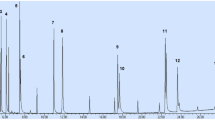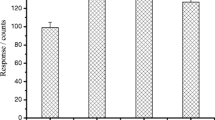Abstract
This study presents a novel method for the analysis of low molecular weight (LMW) fatty acids in cave drip water and speleothems. The method development included optimization of sample preparation procedures, e.g., blank reduction, solid phase extraction, concentration of extracts as well as liquid chromatography coupled to electrospray ion-trap mass spectrometry (HPLC-ESI-IT/MS) measurement parameters. Retention times for five analytes (lauric acid, myristic acid, palmitic acid, stearic acid and arachidic acid) were between 5 and 13.5 min. Spiking experiments were performed to accomplish external calibrations which ranged from 12.5 to 75 ng per spiked water sample. The correlation coefficient ranged from 0.9558 to 0.9989. Inter-batch precision, expressed as the relative standard deviation of three replicates, was <7 %. Limits of detection ranged from 0.77 to 55.97 ng for the diverse analytes; obtained recoveries varied from 30 to 103 %. For a first application, cave drip water and stalagmite samples from Herbstlabyrinth-Adventhöhle cave system were analyzed. Concentrations ranged from 38.37 to 9,982.54 ng L−1 for water samples and 2.52 to 1,344.96 ng g−1 for the stalagmite. Thereby, the different fatty acids showed a distinctive variation. Whereas shorter-chained fatty acids exhibited similarities, arachidic acid showed opposite trends. Diverse correlations were found, which could improve the understanding of different organic sources of the lipids transported by drip water and preserved in speleothems. This new method provides a more selective extraction process, particularly adjusted to LMW fatty acids and therefore reduces the required sample size. Furthermore, it is applicable to stalagmite as well as cave drip water samples.





Similar content being viewed by others
References
Fairchild I, Frisia SBA, Tooth A (2007) Speleothems. In: Nash DJ, McLaren SJ (eds) Geochemical sediments and landscapes. Blackwell, Oxford
Fairchild IJ, Smith CL, Baker A, Fuller L, Spötl C, Mattey D, McDermott F, E.I.M.F. (2006) Modification and preservation of environmental signals in speleothems. Earth-Sci Rev 75(1–4):105–153
Lauritzen S, Lundberg J (1999) Speleothems and climate: a special issue of The Holocene. The Holocene 9(6):643–647
McGarrry SF, Baker A (2000) Organic acid fluorescence: applications to speleothem palaeoenvironmental reconstruction. Quatern Sci Rev 19:1087–1101
Scholz D, Frisia S, Borsato A, Spötl C, Fohlmeister J, Mudelsee M, Miorandi R, Mangini A (2012) Holocene climate variability in north-eastern Italy: potential influence of the NAO and solar activity recorded by speleothem data. Clim Past 8:1367–1383
Blyth AJ, Asrat A, Baker A, Gulliver P, Leng MJ, Genty D (2007) A new approach to detecting vegetation and land-use change using high-resolution lipid biomarker records in stalagmites. Quat Res 68(3):314–324
McDermott F (2004) Palaeo-climate reconstruction from stable isotope variations in speleothems: a review. Quat Sci Rev 23(7–8):901–918
Rushdi AI, Clark PU, Mix AC, Ersek V, Simoneit BRT, Cheng H, Edwards RL (2011) Composition and sources of lipid compounds in speleothem calcite from southwestern Oregon and their paleoenvironmental implications. Environ Earth Sci 62(6):1245–1261
Richards DA, Dorale JA (2003) Uranium-series chronology and environmental applications of speleothems. Rev Mineral Geochem 52:407–460
Dykoski C, Edwards R, Cheng H, Yuan D, Cai Y, Zhang M, Lin Y, Qing J, An Z, Revenaugh J (2005) A high-resolution, absolute-dated Holocene and deglacial Asian monsoon record from Dongge Cave, China. Earth Planet Sci Lett 233(1–2):71–86
Blyth AJ, Shutova Y, Smith C (2013) δ13C analysis of bulk organic matter in speleothems using liquid chromatography–isotope ratio mass spectrometry. Org Geochem 55:22–25
Fairchild IJ, Borsato A, Tooth AF, Frisia S, Hawkesworth CJ, Huang YM, McDermott F, Spiro B (2000) Controls on trace element Sr–Mg/compositions of carbonate cave waters: implications for speleothem climatic records. Chem Geol 166:255–269
Wassenburg JA, Immenhauser A, Richter DK, Niedermayr A, Riechelmann S, Fietzke J, Scholz D, Jochum KP, Fohlmeister J, Schröder-Ritzrau A, Sabaoui A, Riechelmann DFC, Schneide L, Esper J (2013) Moroccan speleothem and tree ring records suggest a variable positive state of the North Atlantic Oscillation during the Medieval Warm Period. Earth Planet Sci Lett 375:291–302
Xie S, Yi Y, Huang J, Hu C, Cai Y, Collins M, Baker A (2003) Lipid distribution in a subtropical southern China stalagmite as a record of soil ecosystem response to paleoclimate change. Quat Res 60:340–347
Xie S, Huang J, Wang H, Yi Y, Hu C (2005) Distributions of fatty acids in a stalagmite related to paleo-climate change at Qingjiang in Hubei, southern China. Sci China Ser D 48(9):1463
Blyth AJ, Baker A, Collins MJ, Penkman KE, Gilmour MA, Moss JS, Genty D, Drysdale RN (2008) Molecular organic matter in speleothems and its potential as an environmental proxy. Quat Sci Rev 27(9–10):905–921
Blyth AJ, Watson JS, Woodhead J, Hellstrom J (2010) Organic compounds preserved in a 2.9million year old stalagmite from the Nullarbor Plain, Australia. Chem Geol 279(3–4):101–105
Blyth AJ, Baker A, Thomas LE, van Calsteren P (2011) A 2000-year lipid biomarker record preserved in a stalagmite from north-west Scotland. J Quat Sci 26(3):326–334
Li X, Wang C, Huang J, Hu C, Xie S (2011) Seasonal variation of fatty acids from drip water in Heshang Cave, central China. Appl Geochem 26(3):341–347
Brassel SC, Eglinton G, Marlowe IT, Pflaumann U, Sarnthein M (1986) Molecular stratigraphy: a new tool for climatic assessment. Nature 320:129–133
Meyers PA (1997) Organic geochemical proxies of paleoceanographic, paleolimnologic, and paleoclimatic processes. Org Geochem 27:213–250
Kögel-Knabner I (2002) The macromolecular organic composition of plant and microbial residues as inputs to soil organic matter. Soil Biol Biochem 34:139–162
Nott CJ, Xie S, Avsejs LA, Maddy D, Chambers FM, Evershed RP (2000) n-Alkane distributions in ombrotrophic mires as indicators of vegetation change related to climatic variation. Org Geochem 31:231–235
Bull ID, van Bergen PF, Nott CJ, Poulton PR, Evershed RP (2000) Organic geochemical studies of soils from the Rothamsted classical experiments-V. The fate of lipids in different long-term experiments. Org Geochem 31:389–408
Zocatelli R, Lavrieux M, Disnar J, Milbeau C, Jacob J, Bréheret JG (2012) Free fatty acids in Lake Aydat catchment soils (French Massif Central): sources, distributions and potential use as sediment biomarkers. J Soils Sediments 12(5):734–748
van Dongen BE, Rijpstra WIC, Philippart CJM, de Leeuw JW, Sinninghe Damste JS (2000) Biomarkers in upper Holocene Eastern North Sea and Wadden Sea sediments. Org Geochem 31:1533–1543
Huang X, Cui J, Pu Y, Huang J, Blyth AJ (2008) Identifying “free” and “bound” lipid fractions in stalagmite samples: an example from Heshang Cave, Southern China. Appl Geochem 23(9):2589–2595
Carrie RH, Mitchell L, Black KD (1998) Fatty acids in surface sediment at the Hebridean shelf edge, west of Scotland. Org Geochem 29(5–7):1583–1593
Ohtonen R, Väre H (1998) Vegetation composition determines microbial activities in a boreal forest soil. Microb Ecol 36:328–335
Yang H, Ding W, Zhang CL, Wu X, Ma X, He G, Huang J, Xie S (2011) Occurrence of tetraether lipids in stalagmites: Implications for sources and GDGT-based proxies. Org Geochem 42(1):108–115
Blyth AJ, Schouten S (2013) Calibrating the glycerol dialkyl glycerol tetraether temperature signal in speleothems. Geochim Cosmochim Acta 109:312–328
Blyth AJ, Farrimond P, Jones M (2006) An optimised method for the extraction and analysis of lipid biomarkers from stalagmites. Org Geochem 37(8):882–890
Wang C, Zhang H, Huang X, Huang J, Xie S (2012) Optimization of acid digestion conditions on the extraction of fatty acids from stalagmites. Front EarthSci 6(1):109–114
Baker A, Barnes WL, Smart PL (1997) Variations in the discharge and organic matter content of stalagmite drip waters in Lower Cave, Bristol. Hydrol Process 11:1541–1555
Ban F, Pan G, Zhu J, Cai B, Tan M (2008) Temporal and spatial variations in the discharge and dissolved organic carbon of drip waters in Beijing Shihua Cave. China Hydrol Proc 22(18):3749–3758
Hoffmann DL, Prytulak J, Richards DA, Elliott T, Coath CD, Smart PL, Scholz D (2007) Procedures for accurate U and Th isotope measurements by high precision MC-ICPMS. Int J Mass Spectrom 264(2–3):97–109
Žák K, Richter DK, Filippi M, Živor R, Deininger M, Mangini A, Scholz D (2012) Coarsely crystalline cryogenic cave carbonate—a new archive to estimate the Last Glacial minimum permafrost depth in Central Europe. Clim Past 8(6):1821–1837
Jochum KP, Wilson SA, Abouchami W, Amini M, Chmeleff J, Eisenhauer A, Hegner E, Iaccheri LM, Kieffer B, Krause J, McDonough WF, Mertz-Kraus R, Raczek I, Rudnick RL, Scholz D, Steinhoefel G, Stoll B, Stracke A, Tonarini S, Weis D, Weis U, Woodhead JD (2011) GSD-1G and MPI-DING reference glasses for in situ and bulk isotopic determination. Geostand Geoanal Res 35(2):193–226
Cheng H, Edwards RL, Hoff J, Gallup CD, Richards DA, Asmerom Y (2000) The half-lives of uranium-234 and thorium-230. Chem Geol 169:17–33
Acknowledgments
J. M. Bosle and D. Scholz acknowledge support by the Geocycles-Earth System Research Center, University of Mainz, Germany. S. A. Mischel and D. Scholz are thankful for funding of the German Research Foundation (DFG grant SCHO 1274/3-1). The authors also thank the anonymous reviewers, who provided useful comments on the manuscript.
Author information
Authors and Affiliations
Corresponding author
Rights and permissions
About this article
Cite this article
Bosle, J.M., Mischel, S.A., Schulze, AL. et al. Quantification of low molecular weight fatty acids in cave drip water and speleothems using HPLC-ESI-IT/MS — development and validation of a selective method. Anal Bioanal Chem 406, 3167–3177 (2014). https://doi.org/10.1007/s00216-014-7743-6
Received:
Revised:
Accepted:
Published:
Issue Date:
DOI: https://doi.org/10.1007/s00216-014-7743-6




